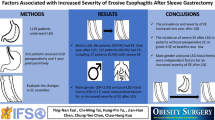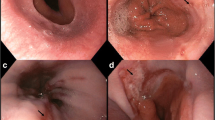Abstract
Background
Laparoscopic sleeve gastrectomy (LSG) is one of the commonest bariatric procedures. However, it is associated with postoperative gastroesophageal reflux disease (GERD) and erosive esophagitis (EE). This study aims to assess the impact of various preoperative clinical and endoscopic characteristics on the development of postoperative GERD and EE.
Methods
This study is a single-institution retrospective cohort study involving all patients who underwent LSG. A univariate and multivariate analysis was performed to identify preoperative parameters that were significantly associated with the development of postoperative GERD and EE, at up to 1-year follow-up.
Results
At up to 1-year follow-up, out of 127 patients, only preoperative endoscopic presence of a hiatal hernia noted on axial length (p=0.024) and the Hill’s classification of the gastroesophageal junction (p<0.001) were significantly associated with the development of postoperative GERD. Similarly, at 1-year follow-up endoscopy, the presence of a hiatal hernia (p=0.041) and the Hill’s classification (p=0.001) were associated with postoperative EE. On the multivariate analysis, compared to patients with a Hill’s I flap valve, Hill’s II patients were more likely to develop postoperative GERD (OR 7.13, 95% CI: 1.69–29.98, p=0.007), and Hill’s III patients were more likely to develop postoperative GERD (OR 20.84, 95% CI: 3.98–109.13, p<0.001) and EE (OR 34.49, 95% CI: 1.08–1105.36, p=0.045). All patients with Hill’s IV developed postoperative GERD and EE in this study.
Conclusion
Postoperative GERD and EE remain an important limitation following LSG. Proper preoperative assessment using the Hill’s classification can help to accurately predict patients at risk of postoperative GERD and EE.
Similar content being viewed by others
References
Berger ER, Huffman KM, Fraker T, Petrick AT, Brethauer SA, Hall BL, Ko CY, Morton JM. Prevalence and Risk Factors for Bariatric Surgery Readmissions: Findings From 130,007 Admissions in the Metabolic and Bariatric Surgery Accreditation and Quality Improvement Program. Ann Surg. 2018 Jan;267(1):122-131.
Peterli R, Wölnerhanssen BK, Peters T, Vetter D, Kröll D, Borbély Y, Schultes B, Beglinger C, Drewe J, Schiesser M, Nett P, Bueter M. Effect of Laparoscopic Sleeve Gastrectomy vs Laparoscopic Roux-en-Y Gastric Bypass on Weight Loss in Patients With Morbid Obesity: The SM-BOSS Randomized Clinical Trial. JAMA. 2018 Jan 16;319(3):255-265.
Salminen P, Helmiö M, Ovaska J, Juuti A, Leivonen M, Peromaa-Haavisto P, Hurme S, Soinio M, Nuutila P, Victorzon M. Effect of Laparoscopic Sleeve Gastrectomy vs Laparoscopic Roux-en-Y Gastric Bypass on Weight Loss at 5 Years Among Patients With Morbid Obesity: The SLEEVEPASS Randomized Clinical Trial. JAMA. 2018 Jan 16;319(3):241-254.
Yeung KTD, Penney N, Ashrafian L, Darzi A, Ashrafian H. Does Sleeve Gastrectomy Expose the Distal Esophagus to Severe Reflux?: A Systematic Review and Meta-analysis. Ann Surg. 2020 Feb;271(2):257-265.
Sgouros SN, Mpakos D, Rodias M, Vassiliades K, Karakoidas C, Andrikopoulos E, Stefanidis G, Mantides A. Prevalence and axial length of hiatus hernia in patients, with nonerosive reflux disease: a prospective study. J Clin Gastroenterol. 2007 Oct;41(9):814-8. doi: https://doi.org/10.1097/01.mcg.0000225678.99346.65.
Lye TJY, Ng KR, Tan AWE, Syn N, Woo SM, Lim EKW, Eng AKH, Chan WH, Tan JTH, Lim CH. Small hiatal hernia and postprandial reflux after vertical sleeve gastrectomy: A multiethnic Asian cohort. PLoS One. 2020 Nov 6;15(11):e0241847.
Assalia A, Gagner M, Nedelcu M, Ramos AC, Nocca D. Gastroesophageal Reflux and Laparoscopic Sleeve Gastrectomy: Results of the First International Consensus Conference. Obes Surg. 2020 Oct;30(10):3695-3705.
Hansdotter I, Björ O, Andreasson A, Agreus L, Hellström P, Forsberg A, Talley NJ, Vieth M, Wallner B. Hill classification is superior to the axial length of a hiatal hernia for assessment of the mechanical anti-reflux barrier at the gastroesophageal junction. Endosc Int Open. 2016 Mar;4(3):E311-7.
Hill LD, Kozarek RA, Kraemer SJ, Aye RW, Mercer CD, Low DE, Pope CE 2nd. The gastroesophageal flap valve: in vitro and in vivo observations. Gastrointest Endosc. 1996 Nov;44(5):541-7.
Sharma A, Aggarwal S, Ahuja V, Bal C. Evaluation of gastroesophageal reflux before and after sleeve gastrectomy using symptom scoring, scintigraphy, and endoscopy. Surg Obes Relat Dis. 2014 Jul-Aug;10(4):600-5.
Rebecchi F, Allaix ME, Giaccone C, Ugliono E, Scozzari G, Morino M. Gastroesophageal reflux disease and laparoscopic sleeve gastrectomy: a physiopathologic evaluation. Ann Surg. 2014 Nov;260(5):909-14; discussion 914-5.
Stenard F, Iannelli A. Laparoscopic sleeve gastrectomy and gastroesophageal reflux. World J Gastroenterol. 2015 ;21(36):10348-57.
Althuwaini S, Bamehriz F, Aldohayan A, Alshammari W, Alhaidar S, Alotaibi M, Alanazi A, Alsahabi H, Almadi MA. Prevalence and Predictors of Gastroesophageal Reflux Disease After Laparoscopic Sleeve Gastrectomy. Obes Surg. 2018 Apr;28(4):916-922.
Lundell LR, Dent J, Bennett JR, Blum AL, Armstrong D, Galmiche JP, Johnson F, Hongo M, Richter JE, Spechler SJ, Tytgat GN, Wallin L. Endoscopic assessment of oesophagitis: clinical and functional correlates and further validation of the Los Angeles classification. Gut. 1999 Aug;45(2):172-80.
Dripps RD. New classification of physical status. Anesthesiol. 1963;24:111
Clavien PA, Barkun J, de Oliveira ML, Vauthey JN, Dindo D, Schulick RD, de Santibañes E, Pekolj J, Slankamenac K, Bassi C, Graf R, Vonlanthen R, Padbury R, Cameron JL, Makuuchi M. The Clavien-Dindo classification of surgical complications: five-year experience. Ann Surg. 2009 Aug;250(2):187-96.
Zacharoulis D, Sioka E, Papamargaritis D, Lazoura O, Rountas C, Zachari E, Tzovaras G. Influence of the learning curve on safety and efficiency of laparoscopic sleeve gastrectomy. Obes Surg. 2012 Mar;22(3):411-5.
Himpens J, Dapri G, Cadière GB. A prospective randomized study between laparoscopic gastric banding and laparoscopic isolated sleeve gastrectomy: results after 1 and 3 years. Obes Surg. 2006 Nov;16(11):1450-6.
Navarini D, Madalosso CAS, Tognon AP, Fornari F, Barão FR, Gurski RR. Predictive Factors of Gastroesophageal Reflux Disease in Bariatric Surgery: a Controlled Trial Comparing Sleeve Gastrectomy with Gastric Bypass. Obes Surg. 2020 Apr;30(4):1360-1367.
Ho KY. Gastroesophageal reflux disease is uncommon in Asia: evidence and possible explanations. World J Gastroenterol. 1999 Feb;5(1):4-6.
Wu JC. Gastroesophageal reflux disease: an Asian perspective. J Gastroenterol Hepatol. 2008 Dec;23(12):1785-93.
Richter JE, Rubenstein JH. Presentation and Epidemiology of Gastroesophageal Reflux Disease. Gastroenterology. 2018 Jan;154(2):267-276.
Hojo M, Nagahara A, Hahm KB, Iwakiri R, Watanabe T, Rani AA, Zhu Q, Chan FKL, Sollano JD, Kamiya T, Yamaguchi S, Motoya S, Fock KM, Fukudo S, Kachintorn U, Suzuki H, Murakami K; The International Gastroenterology Consensus Symposium Study Group. Management of Gastroesophageal Reflux Disease in Asian Countries: Results of a Questionnaire Survey. Digestion. 2020;101(1):66-79.
Holloway RH. The anti-reflux barrier and mechanisms of gastro-oesophageal reflux. Baillieres Best Pract Res Clin Gastroenterol. 2000 Oct;14(5):681-99.
Thor KB, Hill LD, Mercer DD, Kozarek RD. Reappraisal of the flap valve mechanism in the gastroesophageal junction. A study of a new valvuloplasty procedure in cadavers. Acta Chir Scand. 1987 Jan;153(1):25-8.
Kahrilas PJ, Kim HC, Pandolfino JE. Approaches to the diagnosis and grading of hiatal hernia. Best Pract Res Clin Gastroenterol. 2008;22(4):601-16.
Aiolfi A, Micheletto G, Marin J, Rausa E, Bonitta G, Bona D. Laparoscopic Sleeve-Fundoplication for Morbidly Obese Patients with Gastroesophageal Reflux: Systematic Review and Meta-analysis. Obes Surg. 2021 Apr;31(4):1714-1721.
Kusano M, Ino K, Yamada T, Kawamura O, Toki M, Ohwada T, Kikuchi K, Shirota T, Kimura M, Miyazaki M, Nakamura K, Igarashi S, Tomizawa M, Tamura T, Sekiguchi T, Mori M. Interobserver and intraobserver variation in endoscopic assessment of GERD using the “Los Angeles” classification. Gastrointest Endosc. 1999 Jun; 49(6): 700-4.
Author information
Authors and Affiliations
Corresponding author
Ethics declarations
Conflict of Interest
The authors declare no competing interests.
Additional information
Publisher’s Note
Springer Nature remains neutral with regard to jurisdictional claims in published maps and institutional affiliations.
Supplementary Information
Rights and permissions
About this article
Cite this article
Chue, K.M., Goh, D.W.X., Chua, C.M.E. et al. The Hill’s Classification Is Useful to Predict the Development of Postoperative Gastroesophageal Reflux Disease and Erosive Esophagitis After Laparoscopic Sleeve Gastrectomy. J Gastrointest Surg 26, 1162–1170 (2022). https://doi.org/10.1007/s11605-022-05324-x
Published:
Issue Date:
DOI: https://doi.org/10.1007/s11605-022-05324-x





